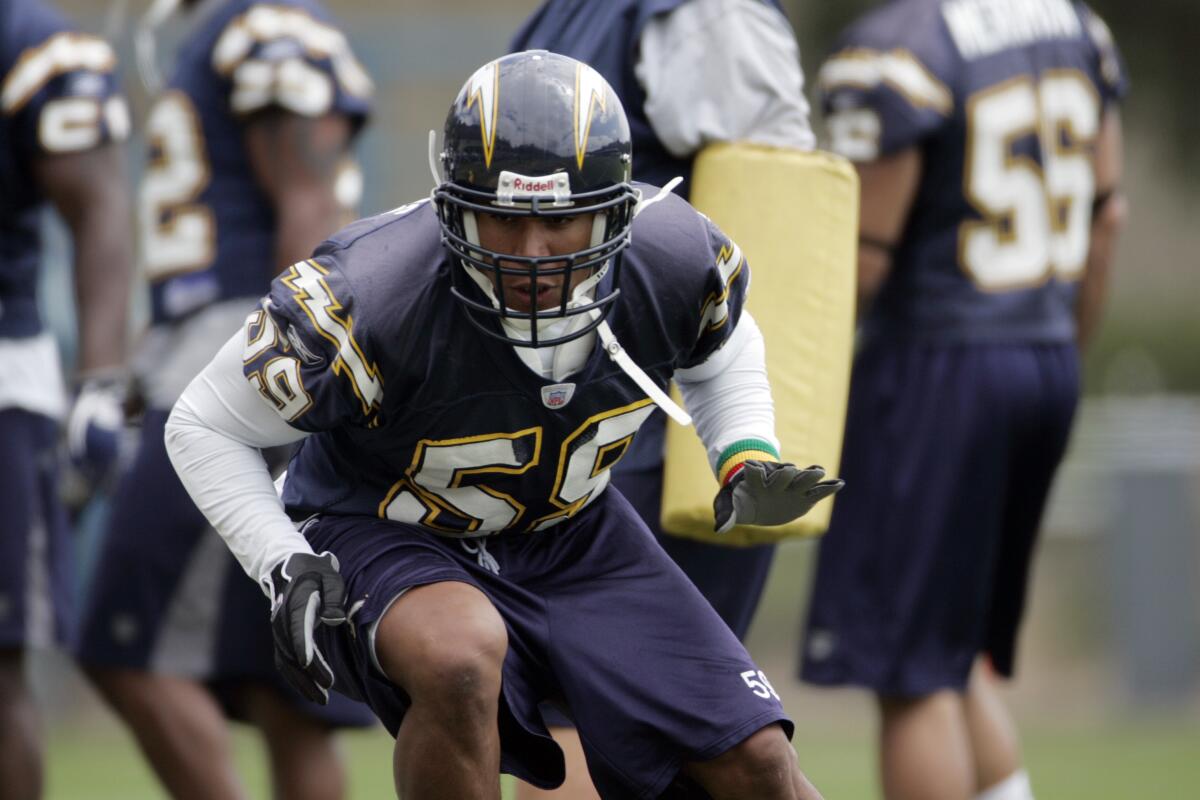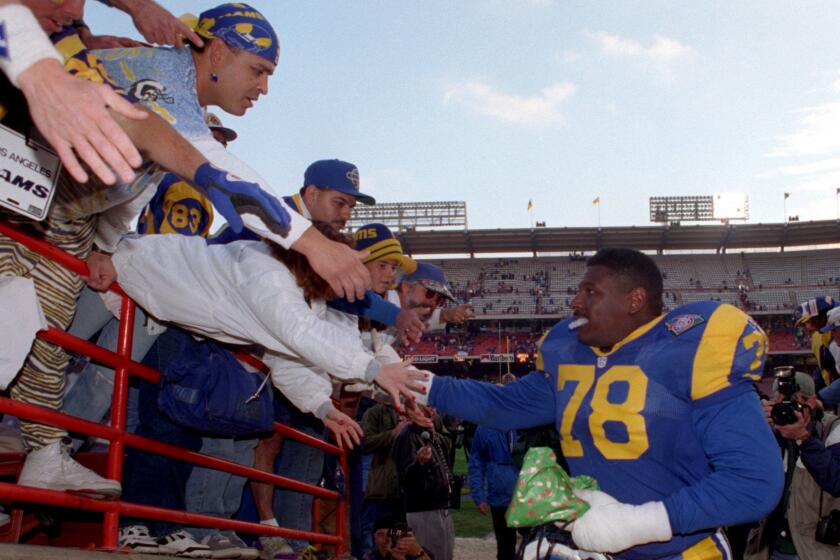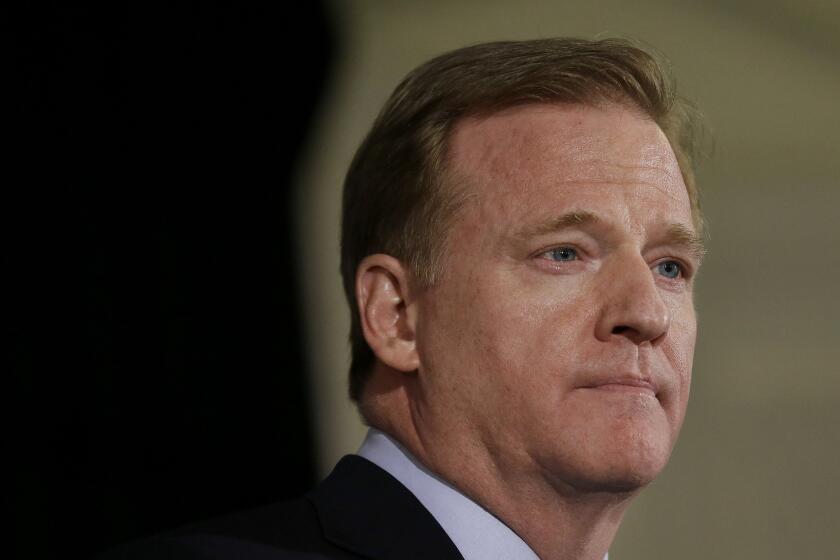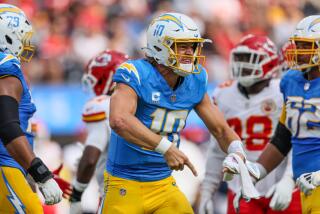Could coronavirus move NFL games? Chargers once played in Arizona during an emergency

- Share via
He couldn’t remember the final score or even which team won.
He can’t forget the flight home, particularly the final minutes.
“I remember you could see all of San Diego County down below just glowing red,” Donnie Edwards said. “It was really scary.”
Nearly 17 years ago — on Oct. 27, 2003 — Edwards and the Chargers played one of the strangest home games in franchise history.
Because of wildfires that eventually would kill 15 people and destroy more than 2,000 structures, the Chargers were forced to relocate to Sun Devil Stadium in Tempe, Ariz., to play host to Miami. With the uncertainty of the upcoming season because of the COVID-19 pandemic, some wonder if relocation could happen again in the fall.
The game was supposed to be a San Diego celebration — the team’s first appearance on “Monday Night Football” in seven years and the return of linebacker Junior Seau, who spent 13 seasons with the Chargers before being traded the previous April to the Dolphins.
While the coronavirus outbreak poses an extremely difficult challenge for the NFL, the league has played games and seasons amid crisis in the past.
Instead, the teams found themselves playing in a hastily prepared neutral site — before some 70,000 spectators who paid nothing to get in — with the words “Arizona” and “Cardinals” in red visibly bleeding through the white “Chargers” painted in each end zone.
“It was chaotic,” recalled Edwards, a former linebacker. “No one was focused on the game. Everyone was focused on what was happening back home. Sometimes in life you have to call an audible. This was the ultimate audible.”
The Chargers fell behind 24-3 by halftime and lost 26-10. Drew Brees threw three interceptions and was sacked six times. One fan held up a sign that read “God Be With Southern California.”
The game wasn’t moved until barely 24 hours before kickoff. The Dolphins already had checked in to their hotel in San Diego. The Chargers’ equipment had been transported from their training facility to Qualcomm Stadium, where the parking lot was being used as an evacuation site.
All of a sudden, then-NFL Commissioner Paul Tagliabue made the decision, and the Chargers and coach Marty Schottenheimer were on a giant Hawaiian Airlines charter, sharing the plane with the team’s cheerleaders and the required home-game personnel.
“We were such a young team that year,” said James Lofton, then a Chargers assistant coach. “You tried not to make too much out of it because it was just one game. But it was tough. Marty really tried to make everything seem as normal as possible.”
While the coronavirus outbreak will make for a unique 2020 season, the Rams endured a pair of unusual seasons in the 1980s.
Once the Chargers ran out onto the field, however, nothing was remotely normal. The place was filled largely with Arizona State students, some of whom had begun lining up for their free tickets 18 hours earlier.
One report noted that by the time the box-office windows opened, “the line snaked for nearly a mile, and the route was littered with ... beer cans and bottles.” Cheers — and boos — burst wildly when either team did something positive.
“You’d turn around and look at the crowd and it looked like a big party,” said Chargers equipment manager Chris Smith, who has been with the team for three decades. “There were a lot of college kids, a lot of people just having a good time and not really caring which team won.”
To mark their return to “Monday Night Football,” the Chargers wore all-navy uniforms, a fashion trend that in today’s NFL has become known as “color rush” but at the time was rare. Edwards said he still regrets not having a photo of himself dressed in the all-blues.
Outside the stadium, five Arizona Cardinals players were among the volunteers who helped collect $200,000 for the San Diego Fire Relief Fund.
Afterward, the late Seau, who still had a home in San Diego, called the night “a struggle” and the game “the hardest” he ever played because of all the conflicting emotions he was feeling.
“I was really disappointed for Junior,” Lofton said. “We all had that game on our radar. Coming back to San Diego, that would have been huge for him.”
NFL coaching staffs will be added to the list of employees who can return to team facilities, and the number of permissible employees will rise from 75 to 100.
Though the Chargers flew back home that night, they didn’t stay long. Less than two days later, they were back on a plane and bound for the University of Illinois.
Because of the situation in San Diego, they practiced at the Fighting Illini’s facility for three days before busing to Chicago to face the Bears in their next game.
They lost that one, too, 20-7.
“A lot of things in life don’t happen the way you expect them to,” Edwards said. “I use that lesson still today when things come up unexpectedly. Whenever I need to, I think back to that Dolphins game and everything surrounding it.”
More to Read
Go beyond the scoreboard
Get the latest on L.A.'s teams in the daily Sports Report newsletter.
You may occasionally receive promotional content from the Los Angeles Times.










